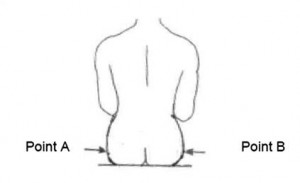Here’s the text of my Well-Mannered Traveler column that appears this week on MSNBC.com. There’s a spirited (and somewhat disappointing) Newsvine discussion about the topic there as well.

(Air Canada’s form instructs doctors on how to measure a traveler’s butt.)
After fighting it for nearly a year, Canada’s major airlines finally unveiled procedures they claim will comply with the Canadian Transportation’s Agency’s “one-person, one-fare” ruling.
On all domestic flights within Canada, the carriers are required to provide additional seating to disabled travelers who must be accompanied by a personal attendant or to travelers determined by medical professionals to be functionally disabled by obesity.
How airlines determine who needs or gets an extra seat has been a thorny issue. On Jan. 10, Air Canada and WestJet announced they will require disabled or obese passengers seeking a second seat to get a note from a doctor and send it in for review well before their flight date.
But doctors, disability rights groups and travelers of all sizes are calling that requirement everything from “too burdensome” to “ludicrous,” and they give the plan’s chances of working a big fat zero.
What’s wrong? Disability rights groups claim the medical forms require passengers to give too much personal information to the airlines. They suggest a third party – one more experienced with these issues – would be better suited for the job.
The Canadian Medical Association (CMA), meanwhile, is complaining that the form asking doctors to measure a patient’s behind “shows a disregard for the use of scarce medical resources.”
Disappointed doctors
“It would have been good if they met with us first,” said Dr. Briane Sharfstein, a spokesperson for the 68,000-member CMA. Sharfstein said doctors throughout Canada are “disappointed” and “concerned” that the airlines didn’t take the time to consult with the organization before deciding to “offload the decision about whether or not someone can fit into a specific seat on an airplane.”
Sharfstein explained that while Canada’s universal health insurance system provides free health care services to all residents, the reality is that patients often wait months to see their doctor. More than 5 million Canadians don’t even have a family doctor, he said.
“We think the majority of individuals seeking a second seat will be individuals who are simply too large to fit into a single airplane seat,” Sharfstein said. “That determination doesn’t require a visit to the doctor. It requires a tape measure.”
Passing the buck
Before the airlines settled on how they’d comply with the “one-person, one-fare” rule, Robert Jarvis, a law professor who specializes in aviation issues, laid out a series of proposed options. Those options ranged from easy (travelers self-declare as obese and get an extra seat) to hard (travelers take a physical exam from a doctor of the airline’s choosing.) Jarvis says he’s not surprised the airlines chose the “moderate” path.
“Clearly, letting travelers decide for themselves that they needed an extra seat would have invited too much abuse. Having the airlines make the decision themselves would have opened the door to all sorts of discrimination lawsuits. So requiring a doctor’s note was the only option really open to the airlines,” Jarvis said.
But Dr. Arya Sharma, an obesity specialist in Canada who also weighed in with some ideas for the airlines, said airlines are passing the buck. “You don’t need to go to medical school to figure out if someone can fit into an airline seat,” Sharma said.
Besides being a burden on doctors, Sharma contends the new system puts an undue burden on travelers. Travelers will have to pay out-of-pocket expenses for a doctor’s visit – and they’ll have to wait. “Most people, for a non-acute medical condition, would have to wait weeks or months before they can see a doctor,” Sharma said. “In my clinic right now the waiting time is approximately one year.”
Make a rule, set a standard
For its part, the Canadian Transportation Association (CTA) is also waiting – and watching. While the agency didn’t order the airlines to choose medical certificates as the litmus test for getting an extra seat, the requirement does technically put the airlines in compliance with “one-person, one-fare,” spokesperson Marc Comeau said.
“Things take time to reach their cruising speed and get rolling,” Comeau said. “Our expectation is that the vast majority of these requests will get dealt with by airlines and their customers.”
Representatives from the National Association to Advance Fat Acceptance (NAAFA) aren’t so sure.
NAAFA’s U.S. co-chair Peggy Howell doesn’t understand why CTA didn’t create standards and guidelines for the airlines to follow. “If you’re going to make a rule, why not set a standard? This way allows airlines to create a whole big mess of paperwork to avoid having to give people what they’ve been ordered to provide,” Howell said.
NAAFA’s Canadian co-chair, Jason Docherty, is alarmed and a bit angry: “Most people won’t want to go through all these steps and give the airlines so much information. It seems like a bullying tactic to get people to not even ask for the second seat.”
What’s next?
“It’s still not rocket science,” says Dr. Sharma. “I suggest the airlines go back and try again.”
Perhaps they will. Representatives from both CMA and the disability rights group Easter Seals Canada are drafting letters and making calls asking the airlines to sit down and talk about changes to their “one-person, one-fare” programs.
In the meantime, get out those tape measures.